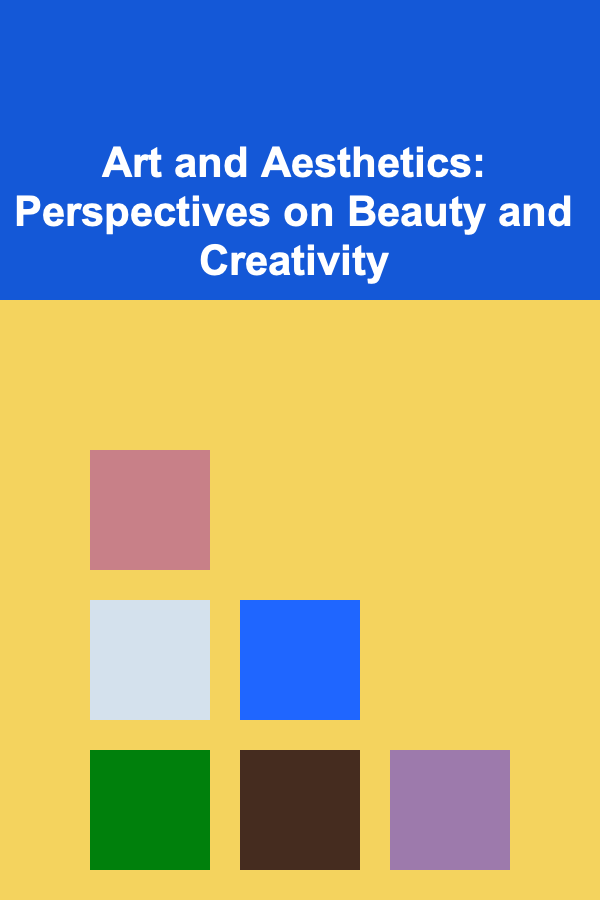
Art and Aesthetics: Perspectives on Beauty and Creativity
ebook include PDF & Audio bundle (Micro Guide)
$12.99$7.99
Limited Time Offer! Order within the next:

Art and aesthetics have been central to human experience for centuries. From the ancient Greeks to modern-day philosophers, the concept of beauty and creativity has sparked deep conversations about what constitutes art, how beauty is perceived, and the role of the artist in shaping the world around us. In this article, we will explore the multifaceted nature of art, aesthetics, and the interplay between creativity and beauty. We will delve into how different schools of thought view these concepts and how they influence our understanding of the world.
The Nature of Beauty: Subjective or Objective?
One of the most debated topics in the realm of art and aesthetics is the nature of beauty. Is beauty something inherent in objects, or is it in the eye of the beholder? This question has been a focal point of philosophical discussions for centuries.
1. Objective Beauty: The Classical Perspective
In classical philosophy, beauty was often viewed as something objective---existing independently of the observer. This perspective is most famously encapsulated by Plato, who argued that beauty was a form that transcended the physical world. According to Plato, the physical manifestations of beauty were mere reflections of a higher, ideal form of beauty, which could only be understood through reason and contemplation. In this view, beauty was not subjective; it existed as a universal, unchanging truth.
2. Subjective Beauty: The Romantic and Modern Perspectives
The Romantic movement, which emerged in the 18th and 19th centuries, challenged the classical view of beauty by emphasizing subjectivity and individual experience. Romantic thinkers, such as Immanuel Kant, argued that beauty is not an inherent property of objects but is a product of the interaction between the object and the observer's mind. According to Kant's "Critique of Judgment," beauty arises from a harmonious relationship between the form of an object and the emotional response it evokes in the viewer.
In modern times, subjective interpretations of beauty have become more prevalent, with artists and philosophers acknowledging that beauty is a personal, cultural, and contextual experience. What one person finds beautiful might not resonate with someone else, and this diversity of perspectives has enriched the landscape of art.
3. The Intersection of Objectivity and Subjectivity: A Balanced View
While the debate between objective and subjective beauty continues, many contemporary thinkers argue for a more integrated view, recognizing both objective and subjective elements in the perception of beauty. Some suggest that there may be universal qualities that contribute to the perception of beauty---such as symmetry, harmony, and proportion---while acknowledging that individual experiences and cultural influences play a significant role in how beauty is perceived.
Creativity: The Heart of Artistic Expression
Creativity is the driving force behind art. It is what transforms the raw materials of the world into something new, something that evokes thought, emotion, or wonder. But what is creativity, and where does it come from?
1. Theories of Creativity
Theories of creativity span across multiple disciplines, including psychology, philosophy, and neuroscience. One of the most influential psychological theories is the four-stage model of creativity proposed by Graham Wallas in 1926. According to Wallas, creativity involves the following stages:
- Preparation: Gathering information and experiences related to the problem at hand.
- Incubation: Allowing ideas to percolate in the subconscious.
- Illumination: The moment of insight or the "aha" moment.
- Verification: Testing the idea and refining it.
This model highlights that creativity is not a sudden, inexplicable burst of inspiration but rather a process that involves both conscious effort and subconscious thinking. While Wallas' model is a useful framework, creativity can manifest in many forms and may be influenced by external factors such as environment, culture, and personal experiences.
2. The Role of Inspiration and Innovation
Throughout history, many artists have spoken about the role of inspiration in their creative process. Some view inspiration as an external force that taps into their consciousness, while others see it as a more personal, internal experience. For example, Vincent van Gogh famously wrote about his deep connection to nature and how it influenced his work, while the Surrealists, including Salvador Dalí, sought to access the unconscious mind through techniques like automatic drawing and dream analysis.
In the modern age, creativity is also seen as a form of innovation---the ability to combine existing ideas in new and meaningful ways. Steve Jobs, the co-founder of Apple, often spoke about innovation as the key to success, and his emphasis on thinking outside the box has inspired a new generation of creators in both the tech and art worlds.
3. Creativity as a Process, Not Just an Outcome
Art is often viewed through the lens of the finished product---a painting, a sculpture, a performance. However, creativity itself is a process that involves experimentation, failure, and discovery. Many contemporary artists emphasize the importance of the journey rather than the destination. For instance, conceptual artists such as Sol LeWitt and Yoko Ono focus on the ideas behind their works, often leaving the execution up to others or even to the audience themselves. This challenges traditional notions of what constitutes art and invites a more inclusive and participatory approach to creativity.
Art as a Reflection of Society and Culture
Art is not created in a vacuum. It is deeply influenced by the culture, politics, and social climate in which it is produced. Throughout history, art has been used as a tool for social change, as well as a means of commenting on or critiquing the status quo.
1. Art as Social Commentary
Many artists throughout history have used their work to comment on societal issues. For example, during the Renaissance, artists like Leonardo da Vinci and Michelangelo used religious themes to reflect on the human condition. In the 20th century, movements like Dadaism and Abstract Expressionism emerged as reactions to the chaos and destruction of World War I and II. More recently, artists such as Banksy have used street art as a form of political activism, challenging consumerism, war, and social inequality.
The idea that art can influence and reflect societal values is central to many artistic movements. Whether through protest art, political art, or simply by portraying the everyday life of common people, artists have long used their work to comment on the world around them.
2. Art and Cultural Identity
Art is also an expression of cultural identity. From indigenous art to African, Asian, and Latin American art traditions, creativity is deeply rooted in the cultural contexts in which it emerges. Artists from different cultural backgrounds bring their unique perspectives, experiences, and values to their work, contributing to a richer and more diverse global art scene.
In recent decades, there has been a growing recognition of cultural appropriation---the act of taking elements from one culture and using them in another, often without understanding or respecting the original meaning. This raises important ethical questions about the ownership and representation of cultural symbols in art and has led to more critical engagement with the cultural context in which art is produced.
The Role of the Artist: Creator, Communicator, and Curator
The artist plays a central role in the world of art, but their role is not limited to being a creator. Artists are often seen as communicators---conveying messages, emotions, and ideas through their work. In today's world, they are also curators, presenting their work in galleries, museums, and public spaces, shaping the way we experience and interpret art.
1. Art as Communication
Art is one of the most powerful forms of communication. It transcends language, cultural barriers, and time. Through visual, auditory, or performative mediums, artists communicate emotions, ideas, and experiences that may be difficult to articulate in words. A painting, a photograph, or a song can convey complex narratives, evoke deep emotions, and challenge preconceived notions about the world.
The role of the artist as a communicator has evolved in the digital age. Social media platforms and online galleries have allowed artists to reach global audiences and foster conversations around their work in ways that were once unimaginable. This democratization of art has expanded the boundaries of creativity and allowed for a more inclusive exchange of ideas.
2. The Curatorial Role of the Artist
In contemporary art, the artist often takes on the role of the curator, not only creating work but also deciding how it is displayed, experienced, and interacted with. The curatorial process can be just as important as the creative process itself, influencing the way audiences engage with the artwork. This has led to an increased focus on site-specific installations, interactive art, and immersive experiences.
Artists today are increasingly exploring the boundaries between the gallery and the public sphere, challenging traditional definitions of art and space. From street art to digital art, artists are reimagining how and where their work can be experienced, creating new dialogues between art and its audience.
Conclusion: The Ever-Evolving Nature of Art and Aesthetics
Art and aesthetics are deeply intertwined with human experience, evolving alongside changes in culture, society, and technology. While the definition of beauty and the understanding of creativity may shift over time, the role of art in expressing human emotions, ideas, and aspirations remains constant. As we continue to explore and engage with the world of art, we are reminded of its power to challenge, inspire, and transform.
The perspectives on beauty and creativity will continue to evolve, shaped by the dynamic interplay between the individual, society, and the world at large. What remains unchanged, however, is the profound impact that art has on our lives---encouraging us to question, reflect, and connect with the world in ways that words alone cannot express.
Reading More From Our Other Websites
- [Home Party Planning 101] How to Select Hen Party Organisers for a Memorable Celebration
- [Organization Tip 101] How to Store Shoes Neatly in a Small Hallway
- [Home Renovating 101] How to Incorporate Modern Design Elements in Your Home Renovation
- [Personal Investment 101] How to Build a Roth IRA in Your 20s
- [Personal Care Tips 101] How to Layer the Best Moisturizers for Face and Body for Intensive Hydration and Protection
- [Home Cleaning 101] How to Tidy Up Your Home in 15-Minute Sessions
- [Personal Investment 101] Create Passive Income Streams by Developing AI-Powered Products
- [Home Rental Property 101] How to Transform Your Garage in Homes for Rent with a Garage into a Versatile Living Space
- [Home Space Saving 101] How to Maximize Space in Your Laundry Room with Organization Tips
- [Metal Stamping Tip 101] Revolutionizing Production: How Metal Stamping Automation Boosts Efficiency and Reduces Costs

How to Design a Functional Essential Oil Station
Read More
How to Renovate Your Basement Into a Livable Space
Read More
How to Store Seasonal Items Without Cluttering Your Home
Read More
The Art of Sales Management: Leading with Vision and Maximizing Sales Potential
Read More
Experiencing the Winter Wonderland of Lapland
Read More
10 Tips for Quilting with Precuts
Read MoreOther Products

How to Design a Functional Essential Oil Station
Read More
How to Renovate Your Basement Into a Livable Space
Read More
How to Store Seasonal Items Without Cluttering Your Home
Read More
The Art of Sales Management: Leading with Vision and Maximizing Sales Potential
Read More
Experiencing the Winter Wonderland of Lapland
Read More